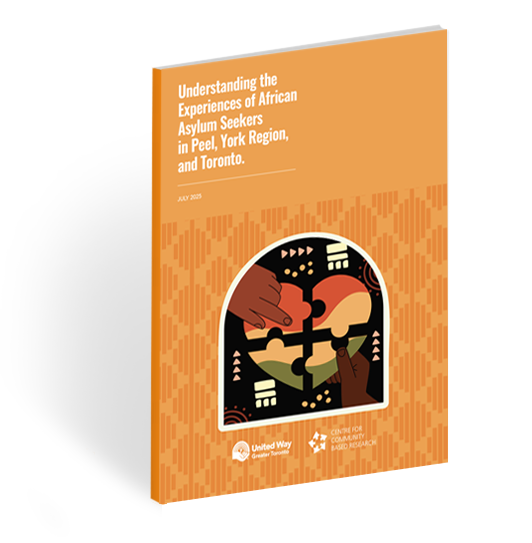A foundation for everything we do
Through groundbreaking research, we can identify and better understand the issues that impact life in our region. Once we improve our understanding, we can better develop sound, long-term strategies for tackling persistent social problems. Research is what allows us to deliver results that make a real impact in our communities—and in the lives of all who live here.
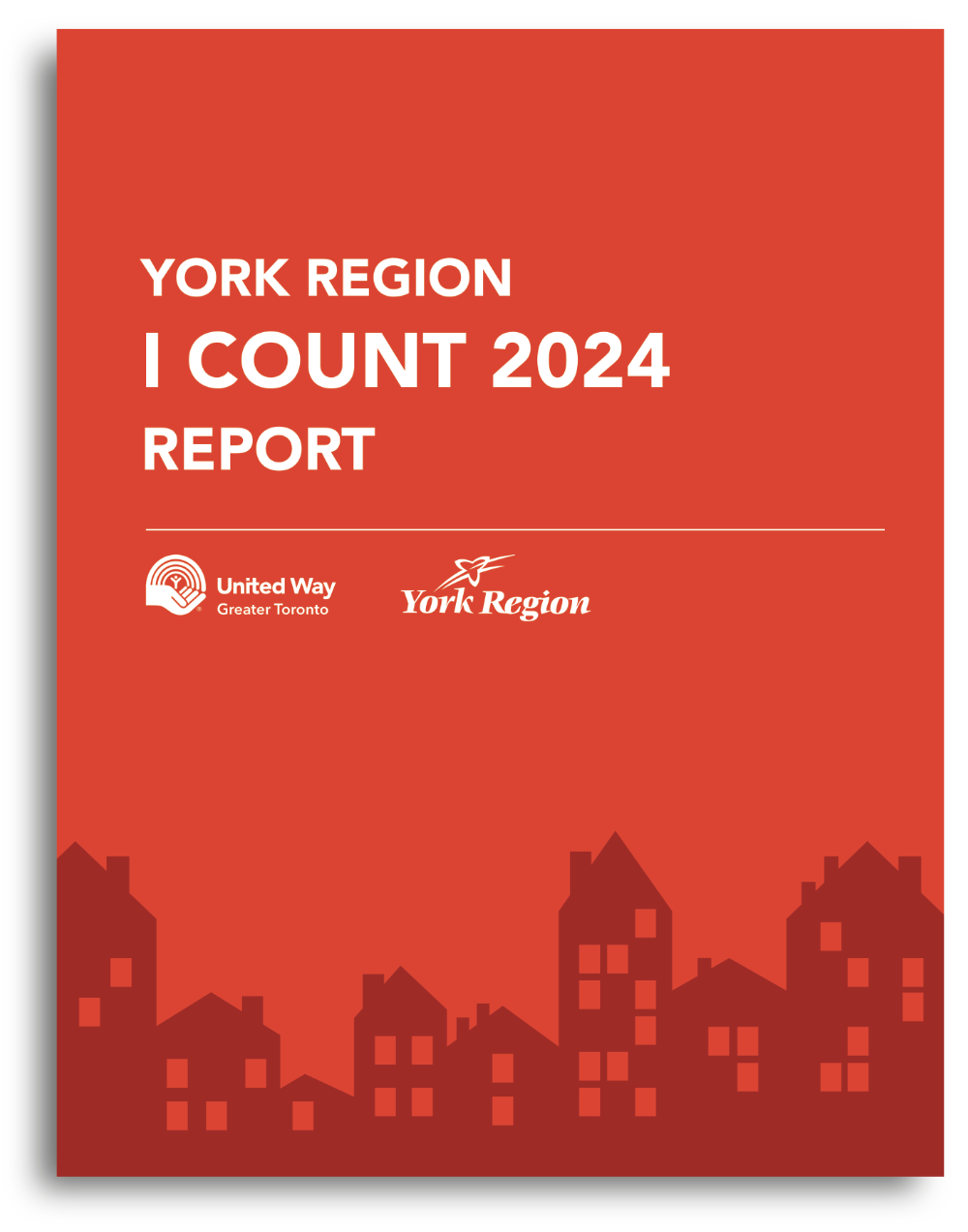
York Region – I Count 2024 Report
A collaboration between United Way Greater Toronto and the Region of York, the Point-in-Time Count 2024 (I Count 2024) was also conducted in partnership with local municipalities, community agencies and volunteers. Revealing sobering results about the rise of homelessness in the region, I Count 2024 shows homelessness in York Region has more than doubled since the last count in 2021, reporting that nearly 880 individuals were counted in 2024 compared to under 330 in 2021. The findings reveal many people and families are struggling with new and pre-existing social and economic challenges, barriers and inequities, and the increase underscores the importance of coordinated action to address them. I Count 2024 is a national enumeration under United Way’s Reaching Home strategy in York Region, which is part of the federal government’s national homelessness strategy that focuses on community-based approaches.
York Region – I Count 2024 Report

Built for Good: Delivering the Housing Ontario Needs
There’s a disconnect between the housing we have and the housing we need, which is the housing most Ontarians can actually afford.
Built for Good: Delivering the Housing Ontario Needs lays out a costed, delivery-ready plan to solve a critical part of the housing crisis. We can build, protect and sustain the affordable housing people need — by investing in the non-profit and co-op housing sector.
Built for Good: Delivering the Housing Ontario Needs
Understanding the Experiences of African Asylum Seekers in Peel, York and Toronto
When hundreds of African asylum seekers arrived in the Greater Toronto Area in 2023, they were met not with welcome, but with waiting: for shelter, for support, for system coordination. The crisis that unfolded on our streets brought long-standing gaps in our support systems into sharp focus.
Developed in partnership with City of Toronto, Region of Peel and York Region Understanding the Experiences of African Asylum Seekers in Peel, York and Toronto reveals the deep and persistent barriers that African asylum seekers continue to face in their resettlement journey — from unaffordable housing and employment discrimination to system anti-Black racism and uneven access to basic supports. The report outlines three key areas for action — from investment to policy change — and further emphasizes the need for increased advocacy to confront anti-Black racism, ensuring that what happened in 2023 is not repeated.
Understanding the Experiences of African Asylum Seekers in Peel, York and Toronto
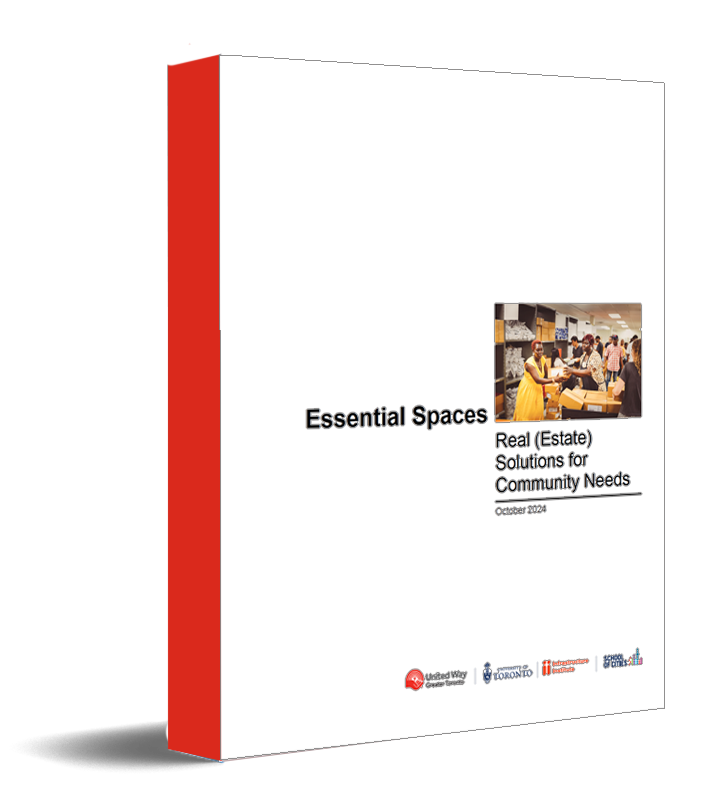
Essential Spaces: Real (Estate) Solutions for Community Needs
Community service organizations are the vital connective tissue that holds our neighbourhoods together, providing an array of essential services, from food pantries to children’s programming, and crucial public space for residents to connect and engage. They’ve supported our region through the most trying of times – pandemic included.
Yet, today, with skyrocketing rental costs, many are at risk, in danger of displacement or closure.
Essential Spaces: Real (Estate) Solutions for Community Needs, developed in partnership with the Infrastructure Institute at the School of Cities, University of Toronto, explores the role of community service organizations in meeting community needs, assesses the space-related risks confronting the sector – and proposes actions we can take today to ensure these valuable community assets continue to strengthen and enrich our neighbourhoods for generations to come.
Essential Spaces: Executive Summary
Essential Spaces: Full Report
Essential Spaces: Appendices
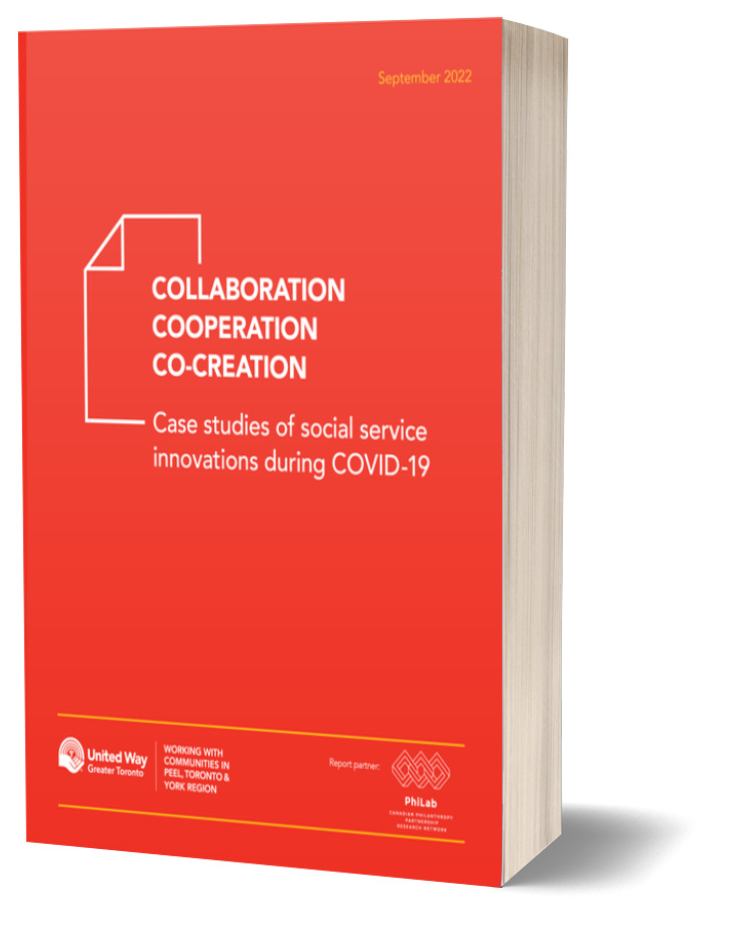
Collaboration, Cooperation, Co-Creation: Case Studies of Social Service Innovations
Throughout the pandemic, United Way Greater Toronto’s network of over 300 funded agencies and community partners mobilized quickly to meet urgent and evolving needs and problem solve in real time – leading to effective innovations that are moving the needle on critical issues facing communities. These case studies, developed in partnership with the Canadian Philanthropy Partnership Research Network (PhiLab), spotlight these innovations and document emerging practices and learnings that can help organizations meet urgent needs, overcome longstanding challenges, and chart a path through future instability and uncertainty. Each case study highlights key practices and enablers that helped catalyze the non-profit sector’s remarkable capacity for agility, adaptation, and leadership during the pandemic, and offers lessons and recommendations to continue unlocking this potential for lasting change beyond the pandemic.
The Be Yourself, See Yourself Pilot Project: Challenges, Lessons and Implications from Collecting Social Identity Data
Auduzhe Mino Nesewinong Clinic (Place of Healthy Breathing): Advancing Indigenous health and data equity
Cedar Centre’s STAIR Group’s virtual program transition: Balancing impact with client safety, privacy, security and cost
Etobicoke recovery site for people experiencing homelessness: Reimagining partnership between the healthcare and community services sector
Apna Health and community health ambassadors in Peel Region: Advancing health equity in the South Asian community
What’s Up Walk-In Clinics’ strengthened network model: Moving along the collaboration continuum

Building Inclusive Communities: Learning from Programs and Policies that Work
The Greater Toronto Area (GTA) is booming. And that rapid growth brings with it added pressures on our infrastructure and communities. This makes it more important than ever to invest in inclusive communities for all residents, existing and new, as we navigate neighbourhood change and build for the future. The good news is we know what interventions work. In this report, we offer a roadmap forward, identifying and unpacking nine programs and policies that have demonstrated success in promoting greater social and economic inclusion and diversity.
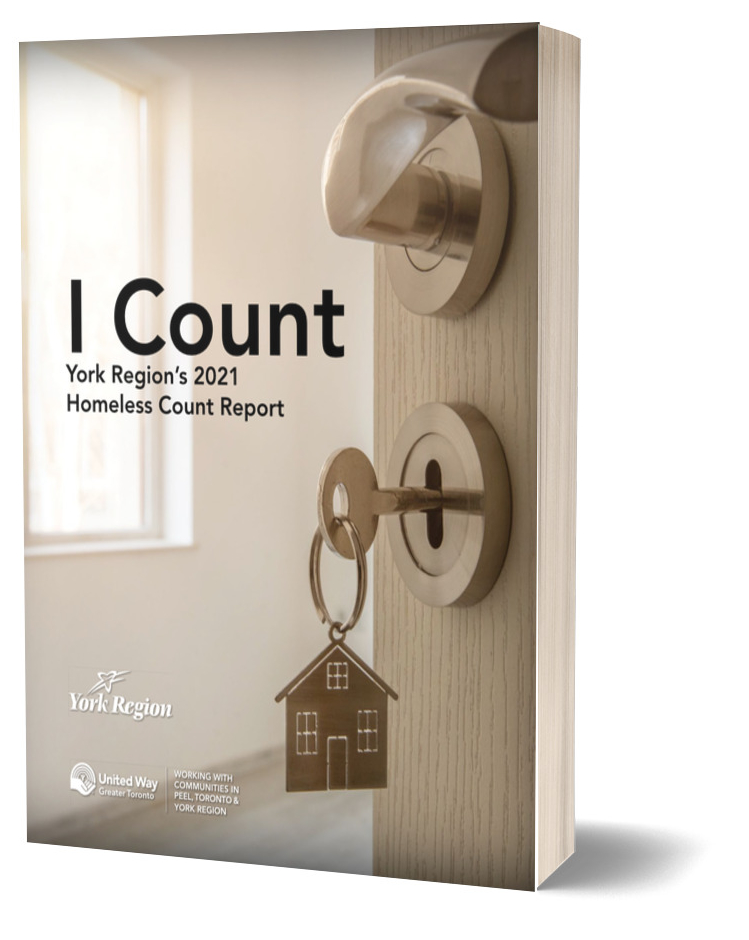
I Count: York Region’s 2021 Homeless Count Report
A collaboration between United Way Greater Toronto and the Regional Municipality of York, I Count 2021 examines who is experiencing homelessness and factors contributing to homelessness in York Region. I Count 2021 is the third homelessness Point-in-Time (PiT) count in York Region, but the first count since the onset of the pandemic. The findings show that the pandemic has had devastating impacts on residents grappling with new and pre-existing social and economic vulnerabilities — including increases in those experiencing homelessness for the first time, increases in those experiencing chronic homelessness, and increases in mental health challenges. Beyond the pandemic, I Count 2021 shows that communities facing systemic barriers and inequities continue to be disproportionately impacted by homelessness. The PiT count is one way that United Way Greater Toronto supports systems level solutions to move the needle on homelessness throughout our region. These findings will guide United Way Greater Toronto and the Regional Municipality of York and as we build on the progress and innovation York Region’s homelessness sector has already made, target investments to match need, and continue to work collaboratively to prevent and end homelessness in York Region.

Vertical Legacy: The case for revitalizing the GTA’s aging rental tower communities
Executive Summary
Decent, secure and affordable housing is a fundamental right. But in the GTA, that right is under threat due to a persistent affordable housing crisis that is deepening social and economic inequities across the region. This United Way Greater Toronto report, published in partnership with the University of Toronto’s Neighborhood Change Research Partnership and the Tower Renewal Partnership, finds that aging high-rise rental towers – an important asset home to thousands and long one of the most affordable housing options in the region– are in jeopardy. Aging and deteriorating and increasingly unaffordable, purpose-built pre-1985 “legacy” rental towers pose health and safety concerns for residents. Most of these residents are low-to moderate-income and racialized households who are already struggling to pay the rent.
Building on progress made over the past decade, this report offers recommendations for all sectors: to help low-income rental tower residents make rent and access eviction protection, to encourage tower owners to maintain good repair and affordability, and to strengthen social infrastructure, services and opportunities for the people and neighbourhoods that call these towers home.
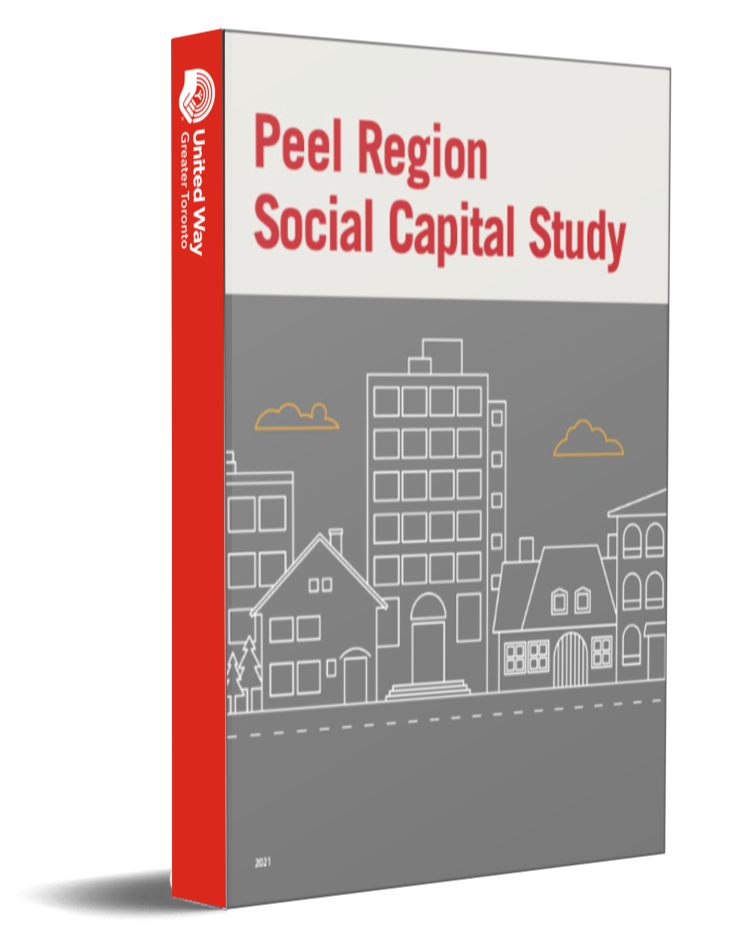
Peel Region Social Capital Study
Peel Region Social Capital Study is the first report to measure social capital in Peel, assessing pre-pandemic baseline levels. Specifically, the report assesses how much residents trust their neighbours and institutions; how extensive and satisfying their social connections are; how civically engaged they are; and how they feel about their neighbourhoods’ safety and services. While the results are largely encouraging, social capital is inequitably distributed: those with lower incomes and less financial security face greater barriers to accessing social capital. The report informs how sectors can work together to overcome those disparities, mitigating crises in the worst of times, and help people thrive in the best of them. This report was conducted in partnership with the Region of Peel, Wellesley Institute, and The Community Foundation of Mississauga.

York Region Social Capital Study
York Region Social Capital Study is the first report to measure social capital in York, assessing pre-pandemic baseline levels. Specifically, the report assesses how much residents trust their neighbours and institutions; how extensive and satisfying their social connections are; how civically engaged they are; and how they feel about their neighbourhoods’ safety and services. While the results are largely encouraging, social capital is inequitably distributed: those with lower incomes and less financial security face greater barriers to accessing social capital. The report informs how sectors can work together to overcome those disparities, mitigating crises in the worst of times, and helping people thrive in the best of them. The study was undertaken with support from The Regional Municipality of York, York Regional Police, and Wellesley Institute.
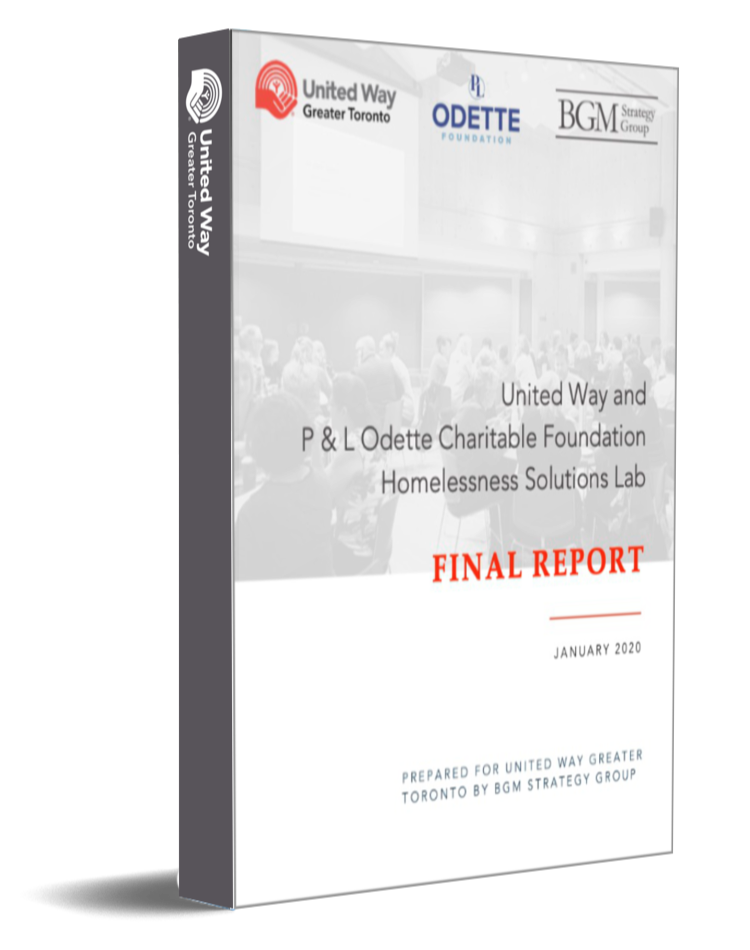
United Way-P&L Odette Charitable Foundation Homelessness Solutions Lab
After decades of emergency response to homelessness, there is growing recognition of the need to focus efforts beyond emergency services. The United Way – P&L Odette Charitable Foundation Homelessness Solutions Lab brought together experts on homeless-serving systems who are innovating and working on solutions—service providers, academics, government partners—to uncover and share the most impactful practices to addressing homelessness. The recommendations in this report, which include enabling Indigenous-led solutions for Indigenous homelessness, identify evidence-based practices that will support system managers and networks, funders, and service providers to make the shift from managing to ending homelessness in the GTA.
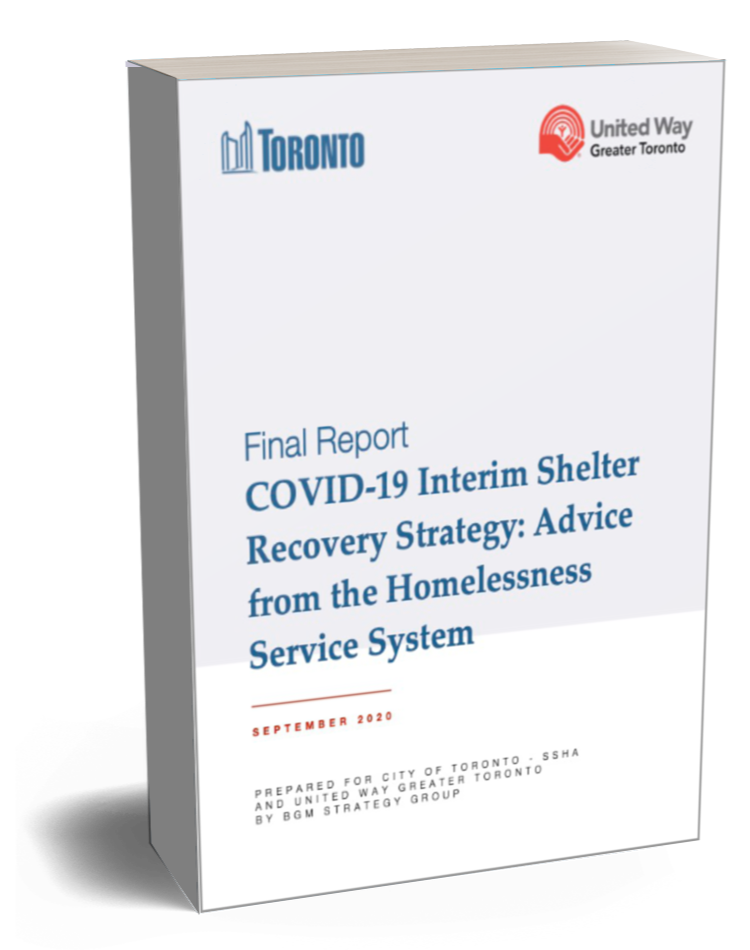
Final Report COVID-19 Interim Shelter Recovery Strategy
Advice from the Homelessness Service System
The City of Toronto’s Shelter, Support & Housing Administration Division (SSHA) partnered with United Way (UWGT) to develop an interim shelter recovery strategy with a task force of key leaders in the homeless-serving sector. The task force generated the advice and recommendations in this report from the collective expertise of contributors, lessons learned from the first phase of the pandemic, and established knowledge about solutions to prevent and end homelessness. Report recommendations will guide SSHA, UWGT, community agencies and other partners in responding to the COVID-19 pandemic in the shelter and homelessness service system over the next 12 months. The report identifies specific short-term actions to strengthen effective shelter service delivery and minimize the spread of COVID-19 in the shelter system over the coming months, names opportunities to move toward more permanent solutions to homelessness, and includes priorities for action to address Indigenous and Black homelessness.

National Housing Collaborative
reflections and analysis of process
This report provides a history of the National Housing Collaborative. It was produced based on one-on-one interviews with participants in the Collaborative process, including both members and non-members, and review of the materials created as part of the process itself. It presents a first-hand account of the Collaborative experience and lessons learned, as understood by the people who witnessed its impact on the National Housing Strategy policy development process, and resulting policy outcomes.
United Way, through its Greater Toronto office, served as the convener and backbone organization for this initiative and supported the creation of this report.

Rebalancing the Opportunity Equation
Executive Summary
Rebalancing the Opportunity Equation looks at income trends between 1980 – 2015, as well as the income gap between young people, immigrants, racialized groups and the rest of the population in Peel, Toronto and York regions. The findings paint a stark picture of who has access to the opportunities to succeed, and who is being left behind because of circumstances they can’t control.
KEY FINDINGS:
- Young adults in the GTA are more disadvantaged today than ever before.
- In the GTA, it doesn’t matter how long you’ve been in Canada, the fact that you weren’t born here means that you are earning less.
- The racial divide in the GTA has reached a historic high.
The report outlines several recommendations that all sectors can act on to ensure everyone can participate in society, enable people to get ahead and make life more affordable.
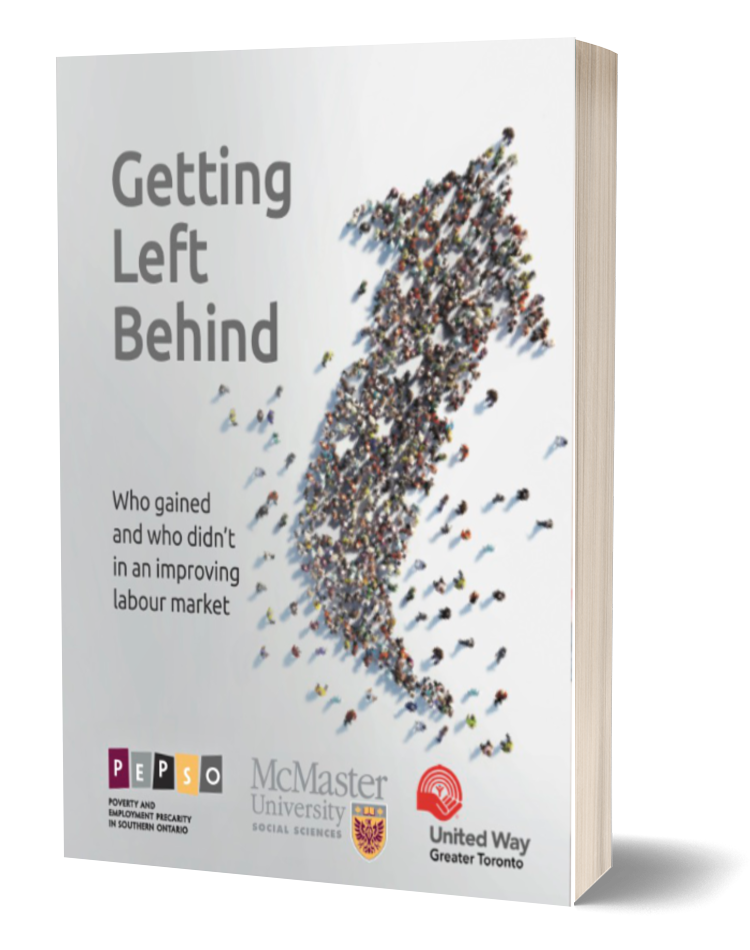
Getting Left Behind
Who gained and who didn’t in an improving labour market
The third report in United Way and McMaster University’s PEPSO series on precarious employment examines who gained and who lost as the labour market improved between 2011 and 2017. Getting Left Behind finds that precarious employment has become imprinted on our labour market and the rising tide of economic growth did not lift all boats. When it comes to landing a secure job in a growing economy, a combination of gender, race and having a university degree determine whether or not you’ll get left behind. It concludes with a call for all sectors to take action and ensure that no one gets left behind. Recommendations include expanding decent work through employment standards and ladders to opportunity, creating a floor of basic income and social supports available to precarious workers, and ensuring that background and circumstances are not a barrier to the labour market.

Better Business Outcomes Through Workforce Security
The labour market is changing, and many workers today are in non-standard jobs. These changes have impacted both workers and businesses, and all across the country there are examples of businesses thinking about how labour market changes require new approaches to their workplaces. This research shows that employers who take action to make their workforce more secure find it’s good for business. Businesses that invest in the security of their workforce tend to have less turnover, lower absenteeism, and higher productivity. The good news is that many Canadian businesses are already leading the way.
Better Business Outcomes Through Workforce Security is a toolkit to help even more businesses move in the right direction. It’s made up of three components:
- A business case framework that shows how improving workforce security benefits business outcomes
- A number of successful case studies from a diverse group of employers
- An assessment tool employers can use to identify practical steps they can take for their own workforces
The report’s goal is to give employers straightforward, incremental action they can take to help make their workforce more secure and strengthen their business.
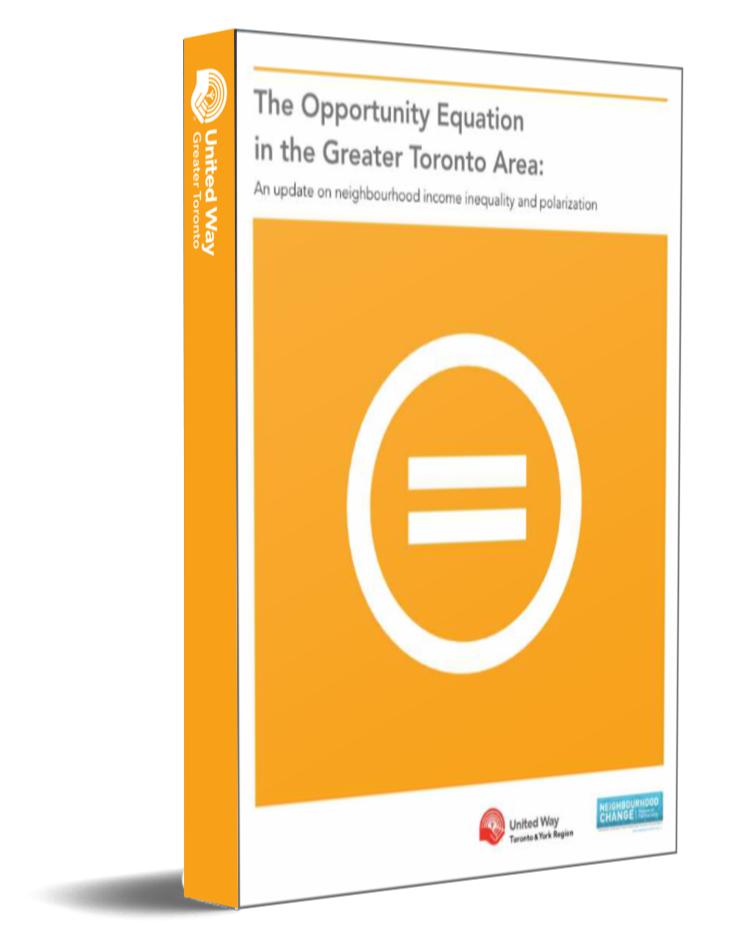
The Opportunity Equation in the Greater Toronto Area
An update on neighbourhood income inequality and polarization
The Opportunity Equation in the Greater Toronto Area uses income data from the 2016 Census to provide the most up to date portrait of neighbourhood income inequality and polarization in the GTA. It shows that the gap between rich and poor has grown dramatically across our region. Across the GTA, middle-income neighbourhoods are vanishing, more neighbourhoods are low-income, and high-income neighbourhoods are getting richer. The picture is bleak in major cities throughout the country, but the gap is worst in the Toronto region. This report confirms the GTA’s unfortunate status as the income inequality capital of Canada. These trends mean that where you live increasingly determines your access to opportunity. This is a real threat to our shared value that everyone should have a fair chance to build a good life.
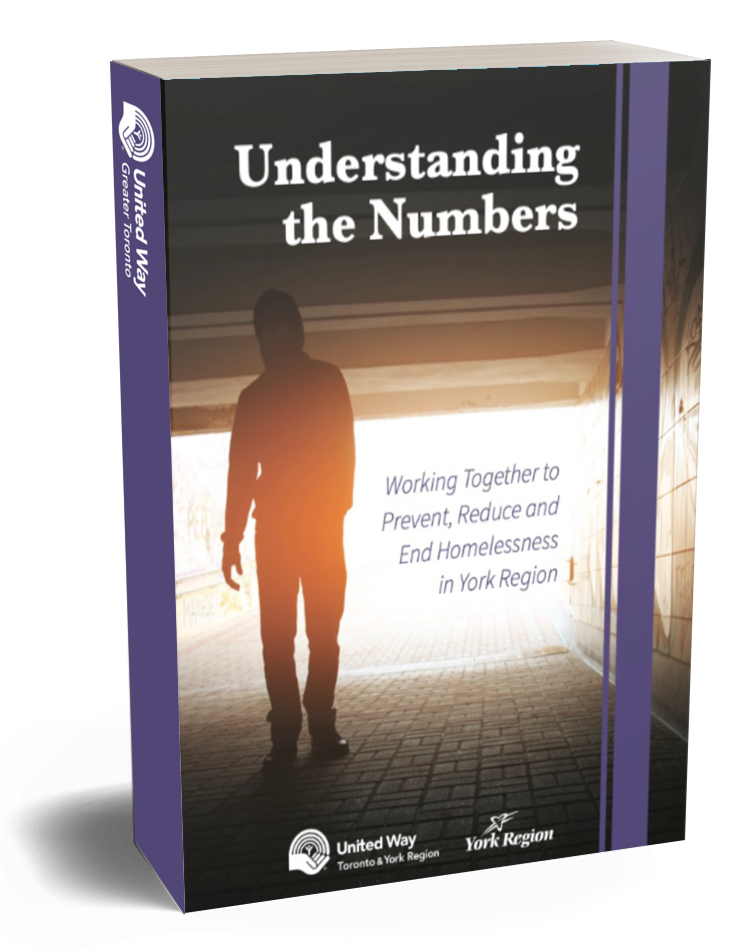
Understanding the Numbers
Working Together to Prevent, Reduce and End Homelessness in York Region
An estimated 235,000 people across Canada are homeless. We often think of this as a downtown issue, but homelessness in suburban communities is a challenge too. In this report, United Way partnered with The Regional Municipality of York to bring together two sets of important data: information gathered during a first-ever point-in-time count of homelessness conducted by United Way, and data collected by the Region through the Homeless Individuals and Families Information System (HIFIS). With this robust data, we learned that homelessness in York Region impacts people from every walk of life—but some populations are at greater risk than others. The information contained in this report will help United Way continue its work with the Region, other levels of government, and other partners to eliminate homelessness in York Region in ten years.

The Precarity Penalty Executive Summary: York Region
We know that precarious employment is a serious and growing issue. Our research tells us that the realities of having an uncertain work schedule, irregular earnings and no benefits are having a negative impact on the wellbeing of residents across the Greater Toronto Area and Hamilton. We’ve now taken a closer look at the labour market in York Region and have uncovered some important findings. In our United Way and McMaster University’s report, The Precarity Penalty Executive Summary: York Region, we’ve learned that insecure employment isn’t just a downtown issue, it’s widespread across York Region. This report outlines this prevalence and illustrates some interesting comparisons too, and underscores our commitment to continue working across all sectors to make real change happen.

The Black Community in Peel
Summary Findings from Four Reports
This summary written in support of the FACES of Peel (Facilitating Access, Change and Equity in Systems) collective provides a snapshot of the social exclusion and discrimination experienced by many Black residents of Peel Region. Black youth report experiencing racism as a part of their everyday lives through negative media portrayals, under-representation in the workforce, treatment at school, and service providers who are ill-equipped to serve their needs and aspirations. Through qualitative data, socio-demographic profiles of the community and its neighbourhoods, a mapping of Black residents, and an inventory of service agencies that serve the community, the reports make recommendations for the education system, police services, municipal governments, community service agencies and funders.
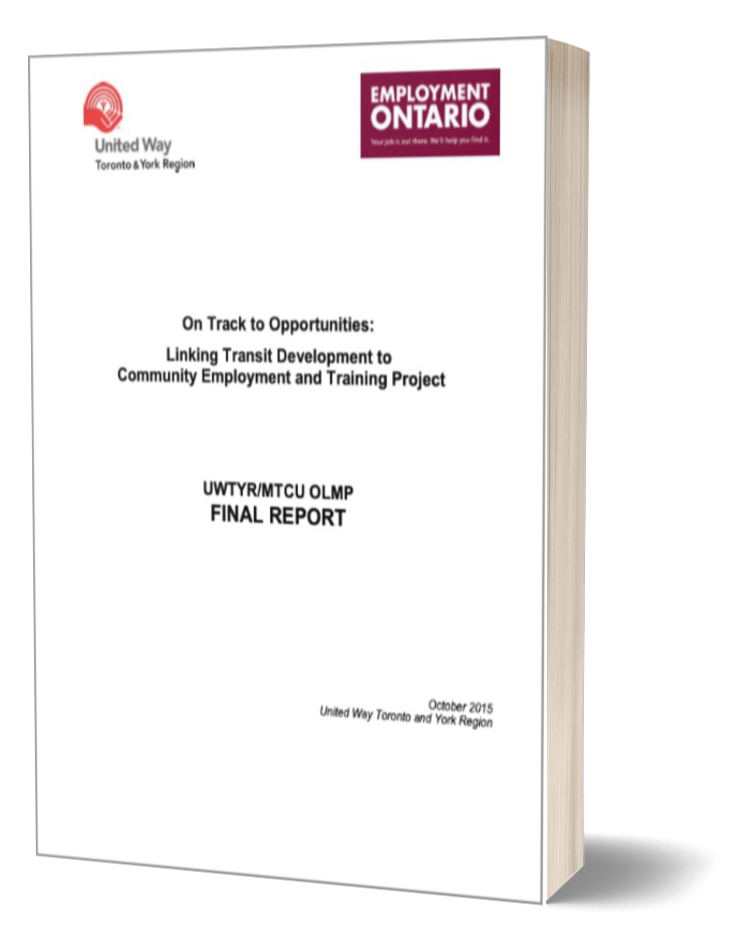
On Track to Opportunities
Linking Transit Development to Community Employment and Training Project
Prospects for residents in Toronto’s priority neighbourhoods can be bleak. Unemployment rates are high. Access to services and supports remain a challenge. Yet, in these very same communities, major infrastructure projects, such as the Eglinton Crosstown LRT, are being launched, bringing with them a demand for skilled labour.What if every time we put a shovel in the ground for infrastructure, we created new opportunities for those at risk of being left behind? That is the groundbreaking idea behind a new Community Benefits framework designed by United Way, community partners and Metrolinx. Based on two years of research and community outreach, this government-commissioned report outlines successful implementation of this bold new approach.

The Precarity Penalty
The impact of employment precarity on individuals, households and communities—and what to do about it
Executive Summary
United Way and McMaster University’s report, The Precarity Penalty, looks at the impact of rising precarious, or insecure, employment in the Greater Toronto Area and Hamilton. Precarious employment penalizes people across all income levels through jobs that offer lower wages, limited benefits and high levels of instability making it difficult to move onto better opportunities. The research also shows that the uncertainty of precarious jobs affects the health and well-being of individuals and families. The report concludes with tangible solutions that focus on modernizing policy and programs for today’s labour market. These include working together with our partners—government, private sector, labour and community groups—to enhance social and community supports, ensure that jobs are a pathway to income and employment security and build a dynamic labour market that responds to the needs of workers in precarious jobs.

The Opportunity Equation
Building opportunity in the face of growing income inequality
Executive Summary
United Way’s new report, The Opportunity Equation, looks at rising income inequality in Toronto and its impact on access to opportunity. Research shows the gap between those who are doing well financially, and those who are not, has grown faster here than in other major Canadian cities. It also finds that hard work is not seen as a guarantee for success. People feel that circumstances beyond individuals’ control, like one’s postal code, family income and background, have become barriers to a good future. The report highlights tangible solutions including partnerships for youth success, community benefits and tools to promote quality jobs. It also calls on multiple partners across the city—including government, private sector, labour and community groups—to work together to mitigate the impact of income inequality in Toronto.

Mapping the mental health system in Peel Region
Challenges and opportunities.
Those dealing with mental health and addictions issues in Peel Region face a scarcity of services, excessive emergency room wait times, and long wait lists for services. While the population is large and growing, funding is not keeping pace and greater ethno-cultural data is needed. Personal factors like shame and stigma around mental illness are also significant factors preventing proper care. By identifying the gaps in service by both geography and type, this report helps hospitals, shelters, the municipality and other service providers make informed decisions about how to most effectively allocate resources.

Leaving Home
Youth Homelessness in York Region
Executive Summary
Those dealing with mental health and addictions issues in York Region face a scarcity of services, Findings reveal a more integrated systems approach is needed to prevent youth from becoming homeless and to stop the flow of young people from institutional care into homelessness. Early intervention was also identified as a preventative measure. The report has a major focus on prevention and is informing United Way’s role as the Community Entity of the federally funded Homelessness Partnership Strategy. emergency room wait times, and long wait lists for services. While the population is large and growing, funding is not keeping pace and greater ethno-cultural data is needed. Personal factors like shame and stigma around mental illness are also significant factors preventing proper care. By identifying the gaps in service by both geography and type, this report helps hospitals, shelters, the municipality and other service providers make informed decisions about how to most effectively allocate resources.
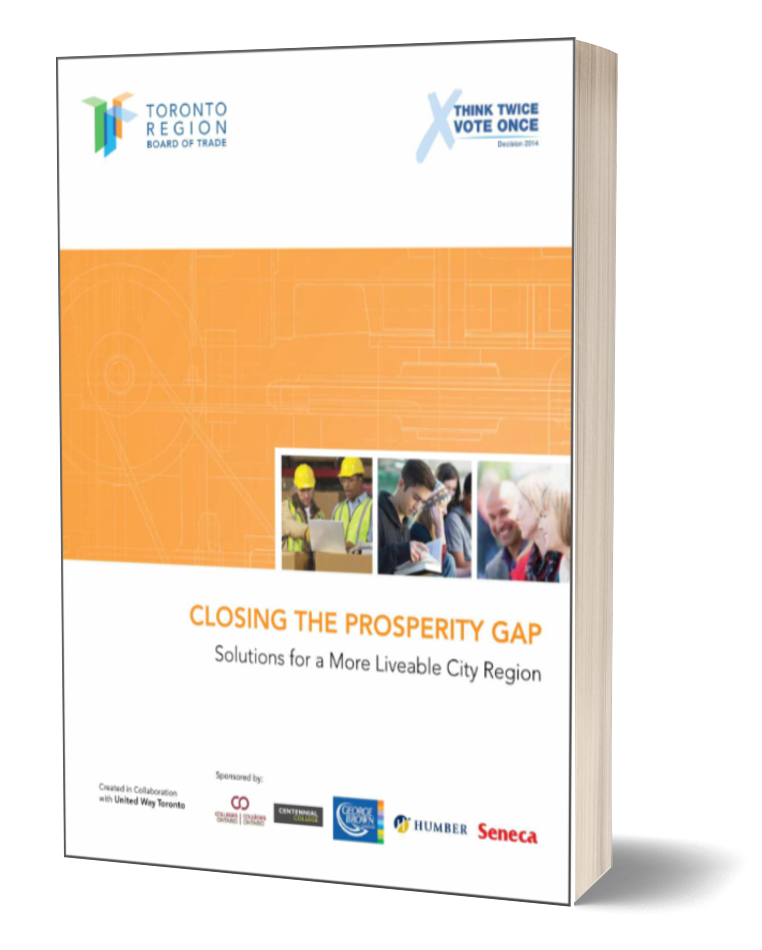
Closing the Prosperity Gap
Solutions for a More Liveable City Region
Fact Sheet
United Way and the Toronto Region Board of Trade’s new report, “Closing the Prosperity Gap: Solutions for a More Liveable City Region”, outlines key issues influencing our region’s prosperity. These issues include: the widening gap in job quality; a growing gap between neighbourhoods doing well and those falling behind; and high rates of youth and newcomer unemployment and underemployment. The report also highlights some tangible ways forward including, community benefits, social enterprise and new zoning. It calls on civic leaders to work with community, business, labour and educators on solutions for this issue.

It’s More Than Poverty
Employment Precarity and Household Wellbeing (PEPSO)
Executive Summary
Released in 2013, this joint report from us and McMaster University examines changes in our local labour market. Of note, 40% of people are now working in precarious jobs (i.e., without benefits or with uncertain futures), which is negatively impacting their lives, their families and their communities. The Government of Ontario responded by investing $13 million in improved enforcement of the Employment Standards Act, and has introduced legislation to further protect precarious workers.

Poverty by Postal Code 2 – Vertical Poverty
Executive Summary
Released in 2011, this report examines the growing number of high-poverty neighbourhoods in the city’s inner suburbs—and the further concentration of poverty in high-rise rental towers in these neighbourhoods. In 2012, we launched the Tower Neighbourhood Renewal initiative, which brings together stakeholders (in four pilot sites) to test strategies for revitalizing tower communities. The City of Toronto has since reformed zoning by-laws to promote neighbourhood vibrancy and development.
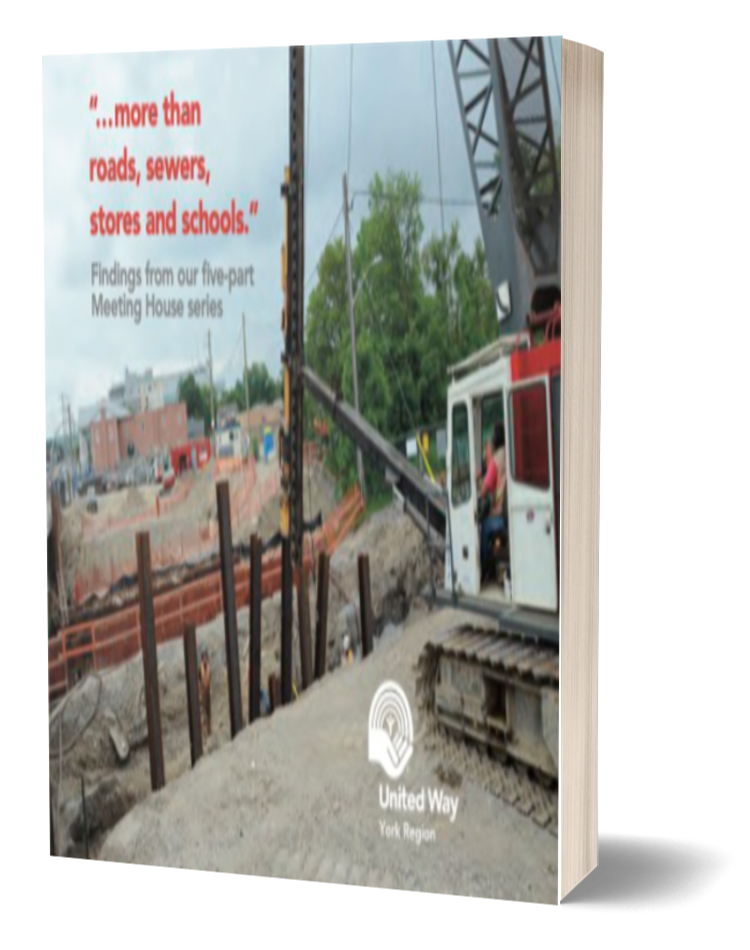
“…More than roads, sewers, stores and schools.”
Findings from our five-part Meeting House series
This report is a culmination of findings from United Way’s 2011 Meeting House series, a five-part community dialogue that explored the need for social infrastructure in York Region. The discussions brought over 250 residents, community groups, businesses and labour partners together to explore new ways to get ahead of pressing social issues.

The Needs and Challenges of the Chinese Community in Peel Region
This 2008 report summarizes a community forum conducted by the Chinese Advisory Council which validated and expanded on findings of a literature review on the needs and challenges of the Chinese community in Peel Region. Of primary concern were employment, language barriers, support for seniors, child care, and parenting skills. Recommendations encompassed systemic responses – to better inform the community about resources and supports, and provide more culture-specific services – as well as personal steps such as learning about Canadian culture and the job market before arrival, improving language skills, and networking.
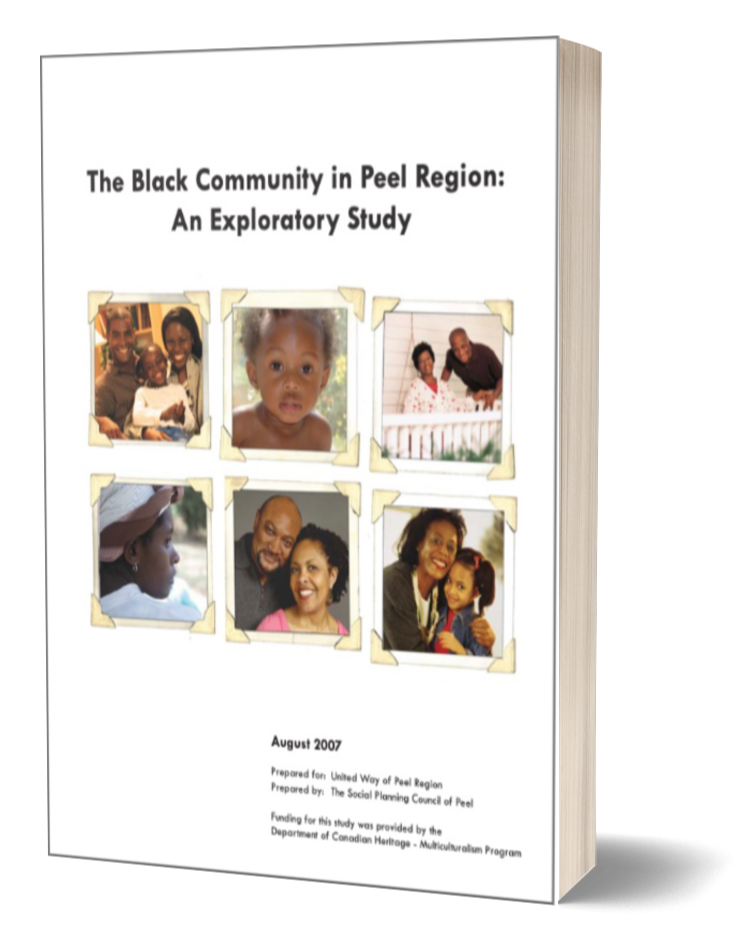
The Black Community in Peel Region
An Exploratory Study
This 2007 report summarizes the challenges impacting quality of life for many Black people in Peel Region. It outlines the diverse ethnic backgrounds, cultures, languages, and faiths represented in the community, and identifies common themes and recommendations. It also highlights some of the human services sector’s gaps in service type and delivery to Black residents of Peel. Among the issues raised through the statistical analysis, literature review, interviews, and focus group discussions found within are racism, intersectional oppressions, poor educational achievement, isolated elderly individuals, limited opportunities for youth, and limited capacity and resources of Black human service organizations.
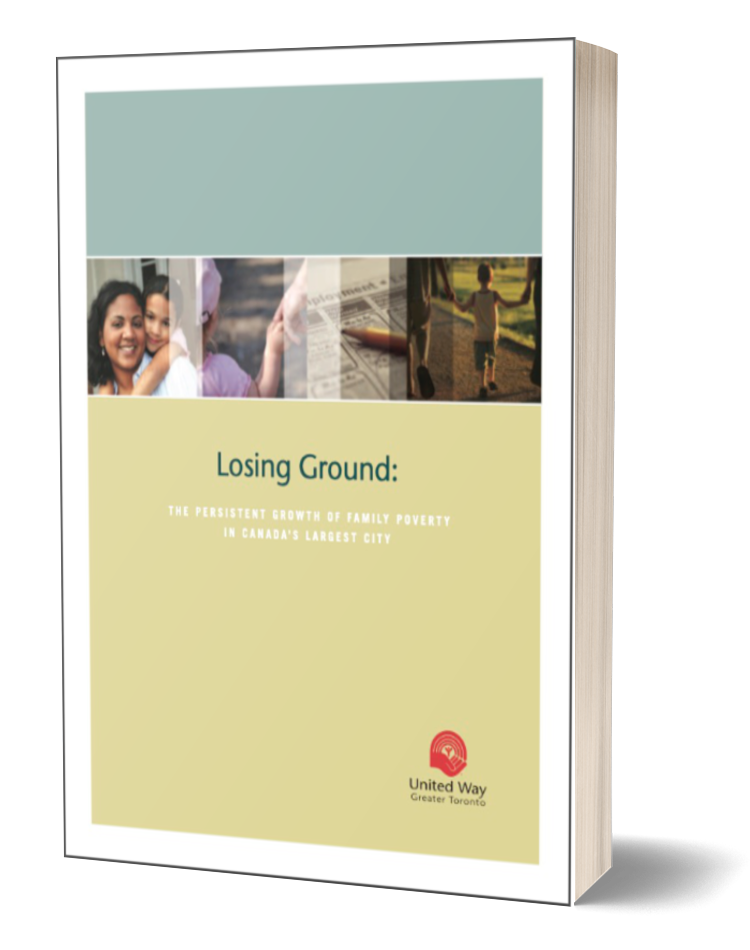
Losing Ground
The persistent growth of family poverty in Canada’s largest city
Executive Summary
Released in 2007, this report examines the growing number of low-income families in Toronto (paving the way for our 2012 report on precarious employment). A key finding about the economic vulnerability of women led to our Women Gaining Ground initiative, which focuses on the education and employment of women. This research also influenced decisions in the Government of Ontario, which introduced a 2007 Poverty Reduction Strategy, supported a committee review of the Payday Loans Act, and brought about changes to the Employment Standards Act.

Strong Neighbourhoods
A call to action
Released in 2005, this report from the Strong Neighbourhoods Task Force (comprising many civic leaders) called for a long-term commitment to strengthen neighbourhoods, through coordinated investment and local resident leadership. It led to our Building Strong Neighbourhoods Strategy, launched in 2005, which outlines a three-pronged approach for revitalizing 13 priority neighbourhoods in Toronto’s inner suburbs. The Government of Ontario aligned community-health-centre projects with five Community Hubs, the federal government invested in Community Hubs through the Infrastructure Stimulus Fund, and private-sector donors became more engaged in funding infrastructure and resident engagement.

Poverty by Postal Code
The geography of neighbourhood poverty
Executive Summary
Released in 2004, this report examines the increase (from 1981 to 2001) in the number of high-poverty neighbourhoods in Toronto—and how the concentration of poverty is impacting vulnerable groups. Supported by the Government of Canada and the Government of Ontario, we came together with the City of Toronto to build an action plan for revitalizing Toronto neighbourhoods. This research and place-based strategy for improving social conditions were cited as a key influence on recommendations for improving supports for young people in our city.

A Decade of Decline
Poverty and income inequality in the city of Toronto in the 1990s
Released in 2002, this foundational report examines how—despite a period of robust economic growth in the late 1990s—the gaps between Toronto’s rich and poor continue to widen. Findings have shaped a robust research agenda into issues related to poverty, marking the first time we identified investment in Toronto’s inner suburbs as an emerging priority. The research informed “Enough Talk: An Action Plan for the Toronto Region,” from the Toronto City Summit Alliance (now called CivicAction).
